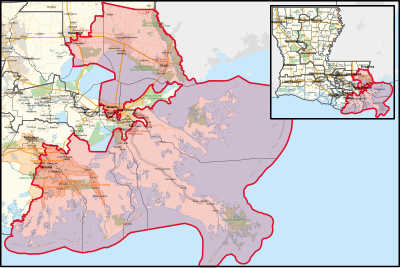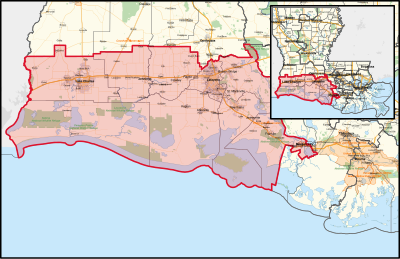


The U.S. stateofLouisiana currently has six congressional districts. The state has had as many as eight districts; the eighth district was eliminated on January 9, 1993 after results of the 1990 census, and the seventh district was eliminated in 2013, following results of the 2010 census, largely because of people moving interstate after Hurricane Katrina hit the state.
Here is a list of members of the United States House delegation from Louisiana, their terms, their district boundaries, and the district political ratings according to the CPVI. The delegation currently has a total of six members: five of the current representatives are Republicans, and the other is a Democrat.
In 2023, the U.S. Circuit Court of Appeals found that the drawing of Louisiana’s congressional districts was an illegal racial gerrymander by the Republican-controlled legislature, drawn to dilute the influence of African-Americans and lock in White majorities in five out of six districts, despite the former making up a third of Louisiana's population. The court ordered the maps be redrawn with a second district with an African-American majority to reflect the state's demographics and allow them to elect a representative of their choice.[1]
The case was caught up in appeals for several months, however the Louisiana State Assembly eventually passed updated congressional maps to adhere to the court’s ruling, resulting in a second district with an African-American majority, and widely expected to increase Democratic representation in the state from one to two congressmen (due to racial polarization in the state), at the expense of the 6th district's incumbent Garret Graves.[2] An attempt to disqualify the new map by a fresh lawsuit was put on hold by the Supreme Court, letting the map be used for the 2024 elections.[3][4]
| Current U.S. representatives from Louisiana | |||||
|---|---|---|---|---|---|
| District | Member (Residence)[5] |
Party | Incumbent since | CPVI (2022)[6] |
District map |
| 1st |  Steve Scalise (Jefferson) |
Republican | May 3, 2008 | R+22 | 
|
| 2nd |  Troy Carter (New Orleans) |
Democratic | May 11, 2021 | D+25 | 
|
| 3rd |  Clay Higgins (Lafayette) |
Republican | January 3, 2017 | R+21 | 
|
| 4th |  Mike Johnson (Benton) |
Republican | January 3, 2017 | R+14 | 
|
| 5th |  Julia Letlow (Start) |
Republican | April 14, 2021 | R+17 | 
|
| 6th |  Garret Graves (Baton Rouge) |
Republican | January 3, 2015 | R+18 | 
|
Table of United States congressional district boundary maps in the State of Louisiana, presented chronologically.[7]
| Year | Statewide map | New Orleans highlight |
|---|---|---|
| 1973–1982 | 
|

|
| 1983–1984 | 
|

|
| 1985–1992 | 
|

|
| 1993–1994 | 
|

|
| 1995–1996 | 
|

|
| 1997–2002 | 
|

|
| 2003–2012 | 
|

|
| 2013–2023 | 
|

|
| 2023–2025 |  |
See District of Louisiana, Louisiana Territory, Territory of Orleans.
Louisiana was purchased from France in 1803, and the territory was organized into the District of Louisiana and the Territory of Orleans in 1804. Areas that are within the current boundaries of Louisiana, but were outside the Territory of Orleans, were ceded by the Spanish in the Adams-Onís Treaty of 1819. From 1806 until 1811, the Territory of Orleans sent one non-voting delegate to the U.S. House of Representatives. Upon Louisiana's admission to the United States in 1812, and until 1823, Louisiana had only one at-large representative. In 1823, three districts were granted to Louisiana. By 1875, Louisiana had six districts.
|
| |
|---|---|
|